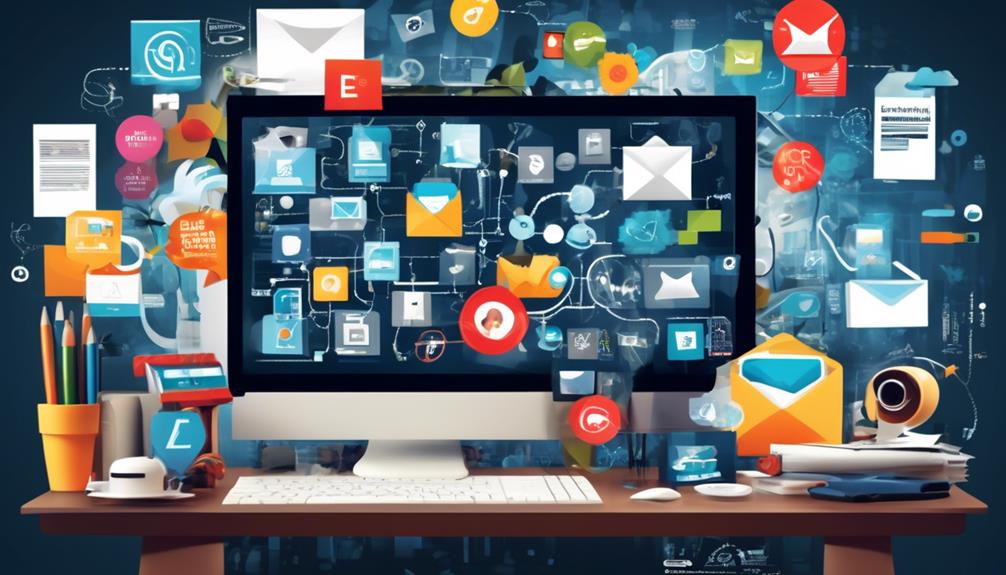To create ADA-compliant email templates, focus on accessibility from the start. Use simple layouts and high-quality content to enhance readability. Make sure to have clear, descriptive subject lines and proper HTML headings for better navigation. Always add alt text for meaningful images, ensuring it's concise and descriptive. Use contrasting colors to improve visibility and avoid using tables for layout. Test your templates with accessibility tools to catch any issues before sending. This approach not only meets legal standards but also improves the overall user experience. Keep going to discover more tips for enhancing your email designs!
Key Takeaways
- Use simple layouts with one or two columns to enhance readability across all devices.
- Ensure color contrast meets a minimum ratio of 4.5:1 for better accessibility.
- Add clear, descriptive subject lines and use proper HTML headings for logical content structure.
- Include alt text for all meaningful images to assist visually impaired users in understanding content.
- Test email templates with accessibility tools and conduct manual audits for compliance verification.
Importance of ADA Compliance

When it comes to email communication, guaranteeing ADA compliance isn't just a legal necessity—it's a commitment to inclusivity. With around 61 million adults in the U.S. living with disabilities, accessible emails are vital in providing equal access to information. Ignoring this legal obligation can lead to significant repercussions, especially as courts increasingly apply ADA standards to online communications, including emails.
Additionally, by implementing strategies such as budget management, organizations can allocate resources effectively to enhance their compliance efforts.
Moreover, ADA compliance isn't solely about avoiding legal issues; it's also a moral responsibility. By designing accessible emails, you enhance user experience for all recipients, including those with temporary impairments. This approach creates a more inclusive environment that values every individual's right to communicate effectively.
Implementing ADA-compliant email templates can also broaden your market reach. With about 1 billion people globally facing some form of disability, you stand to benefit from adopting inclusive communication strategies.
Designing Accessible Email Templates

When you're designing accessible email templates, keep your layout simple with one or two columns to improve readability on all devices.
Prioritizing content quality not only enhances accessibility but also creates a more user-friendly experience.
Make sure your color contrast meets guidelines to help users with visual impairments easily read your content.
These design choices not only enhance accessibility but also create a more user-friendly experience.
Simple Layout Design
Creating an effective email template means prioritizing a simple layout that enhances accessibility. By opting for a one- or two-column design, you improve readability across various devices and screen sizes. Avoid using tables for layout, as they can confuse assistive technology. Instead, utilize native tools to structure your email clearly.
Here's a simple layout guide to help you keep things organized:
| Element | Description |
|---|---|
| Font Sizes | Use consistent sizes for headings and body text. |
| White Space | Include ample space between sections for clarity. |
| Consistency | Maintain the same font styles and colors throughout. |
| Readability | Guarantee text is legible and easy to scan. |
| WCAG Guidelines | Test your design with accessibility tools to guarantee compliance. |
Color Contrast Guidelines
Color contrast is vital for designing accessible email templates that everyone can read easily. To enhance readability for users with visual impairments, you should guarantee a minimum color contrast ratio of 4.5:1 between your text and background colors, as recommended by the Web Content Accessibility Guidelines (WCAG).
High contrast combinations, like dark text on a light background, are generally more accessible and easier to read across different devices and lighting conditions. Incorporating AI's impact on business can also provide insights into optimizing design strategies for accessibility.
When you're creating your email templates, avoid relying on color alone to convey important information. Instead, combine color with text labels or symbols to guarantee clarity for all users.
It's also vital to use tools like the TPGis Color Contrast Analyser for testing color contrast ratios before finalizing your designs.
Key Elements of Email Accessibility

Accessibility in email design is vital for guaranteeing that all users, especially those with disabilities, can engage with your content effectively. To create email accessible to people, you should follow several key elements that align with best practices for creating inclusive communications.
Implementing effective email marketing strategies can also enhance your overall outreach.
Start with a clear and descriptive subject line; this enhances user experience and aids comprehension, particularly for recipients using assistive technologies.
Utilize proper HTML headings to establish a logical order within your email, making it easier for screen readers to navigate and interpret the content structure.
Make sure you maintain a sufficient color contrast ratio of at least 4.5:1 between text and background colors. This is vital for readability across diverse visual impairments.
Additionally, use descriptive link text instead of generic phrases like "click here." This helps visually impaired users understand the purpose of links, improving overall navigation within your email.
Lastly, remember to add alt text to all meaningful images. This provides context for visually impaired users and makes certain the information conveyed by the image adheres to the Content Accessibility Guidelines (WCAG).
Adding Alt Text to Images

When you include images in your emails, adding alt text is essential for ensuring that all recipients, especially those using screen readers, can understand the content. Alt text serves as a textual alternative that conveys information about the images, making your emails more accessible to the visually impaired.
Ensuring accessibility is vital not just for images but also for cold medications overview, as it highlights the importance of clear communication in health-related content.
When creating alt text, aim for concise yet descriptive text that clearly explains the image without duplicating surrounding text. For example, instead of saying "a cat," you might write "a fluffy orange cat lounging on a windowsill." This descriptive text helps screen readers provide meaningful context to users.
If you're using Outlook, you can easily edit alt text by right-clicking the image and selecting "Edit Alt Text." In Gmail, click "Edit alt text" after inserting an image. Remember, if your image contains text, include that text in the alt text or the email body to maintain accessibility.
It's also important to avoid adding alt text to purely decorative images, as this can confuse screen reader users. Instead, use 'role=presentation' to indicate that the image doesn't convey important information.
This attention to detail enhances the overall accessibility of your email.
Best Practices for Email Content

When crafting your email content, make sure to use clear subject lines that grab attention and stay under 50 characters.
Additionally, incorporating elements of best practices in software quality assurance can enhance the overall quality of your emails.
Descriptive link text is just as important; it helps users understand where they'll end up when they click.
Clear Subject Lines
Crafting effective subject lines is essential for engaging your audience and guaranteeing your emails are opened. To achieve this, focus on creating clear subject lines that are concise, ideally limited to 50 characters. This helps maintain readability across devices and prevents truncation in email previews. Descriptive subject lines enhance user experience by accurately indicating the email's content, making it easier for recipients to prioritize their reading.
Additionally, implementing best practices for employee background checks can further improve communication clarity and trust among your audience.
Use plain language in your subject lines to improve understanding, catering to a wider audience, including those with cognitive disabilities or language barriers. Avoid vague terms like "Important" or "Update"; instead, specify the key topic or action required. This provides the clarity your readers need to engage with your content effectively.
Additionally, guarantee consistent formatting in your subject lines, such as capitalization and punctuation. This not only helps maintain professionalism but also aids users in quickly scanning their inbox.
Descriptive Link Text
Descriptive link text is vital for enhancing email accessibility and user experience. By using clear and specific language, you help users, especially those relying on assistive technologies, understand the purpose of each link.
In a world increasingly reliant on digital communication, it's important to strike a balance between accessibility and creativity in your content. Emphasizing the significance of nurturing an imaginative mindset can lead to more engaging and inclusive emails.
Here are some best practices for creating descriptive link text:
- Be Clear: Use text that clearly conveys the destination or purpose of the link, avoiding vague phrases like "click here."
- Be Concise: Limit your link text to 5-7 words to maintain clarity and readability for all users, including screen reader users.
- Use Unique Text: When multiple links lead to the same destination, make sure each link has unique text to provide better context and navigation.
- Test with Users: Gather feedback from users, particularly those with disabilities, to improve accessibility compliance in your email communications.
Multimedia Accessibility Considerations

Multimedia elements can greatly enhance your email templates, but it's important to guarantee they're accessible to all users. To guarantee you cater to people with disabilities, here are some key considerations:
| Element | Accessibility Consideration | Why It Matters |
|---|---|---|
| Video Content | Include accurate captions | Supports individuals with hearing impairments and enhances comprehension. |
| Audio Content | Provide transcripts | Aids those who prefer reading and helps with hearing difficulties. |
| Media Controls | Use keyboard-accessible controls | Allows users with mobility impairments to navigate easily. |
| Images and Graphics | Add detailed alt text and descriptions | Ensures users with visual impairments can understand the context. |
Additionally, avoid auto-playing multimedia as it can create accessibility issues, particularly for those relying on screen readers or assistive technologies. By following these best practices, you'll make your email templates more inclusive and provide a better experience for all users. Remember, accessible multimedia doesn't just benefit people with disabilities; it enhances the experience for everyone.
Testing for Email Accessibility

When it comes to guaranteeing your email templates are accessible, testing is essential.
You'll want to adopt a thorough approach that combines automated tools and manual audits to effectively identify potential accessibility issues. Incorporating insights from affiliate marketing strategies can also enhance user engagement in your emails.
Here are some key steps you should follow:
- Utilize Testing Tools: Regularly use platforms like accessible-email.org and Email on Acid to analyze your email templates for ADA standards compliance.
- Conduct Manual Audits: Verify color contrast ratios, heading structures, and alt text for images to confirm everything meets accessibility needs.
- Implement Descriptive Links: Guarantee all hyperlinks use descriptive text, making it easier for users relying on screen readers to navigate your emails.
- Gather User Feedback: Create feedback mechanisms for users with disabilities to share their experiences, allowing for continuous improvement of your email accessibility.
Resources for Email Accessibility

Creating accessible email templates requires the right tools and resources. By utilizing these resources, you can guarantee your email marketing campaigns comply with the Americans with Disabilities Act (ADA) and meet the Web Content Accessibility Guidelines (WCAG). Here are some valuable tools to take into account:
| Resource | Description |
|---|---|
| Accessibility Checker | Built into Microsoft Outlook, it identifies accessibility issues in your emails. |
| Mailchimp & Constant Contact | These platforms offer features for adding alt text and guaranteeing mobile-friendly designs. |
| Accessible-email.org | Analyzes HTML code for compliance with email accessibility standards. |
| Email on Acid | Tests email templates for color contrast and screen reader compatibility. |
| Regular Manual Audits | Conduct audits to maintain ADA compliance and enhance overall user experience. |
Using alt text for images and guaranteeing proper color contrast will help make your emails more accessible. Regularly testing your templates with tools like the Accessibility Checker will keep you compliant and improve the experience for all recipients, including those using screen readers. By leveraging these resources, you'll create more inclusive and accessible email templates.
Legal Implications of Non-Compliance

Ignoring ADA compliance in your email communications can lead to serious legal consequences, including costly lawsuits and settlements.
With courts increasingly ruling that the ADA applies to online content, you risk financial penalties and damage to your brand's reputation.
In addition, ensuring accessibility can enhance your customer outreach and engagement, making it vital for businesses to adopt best practices in communication, such as transparent fee structures.
Ensuring accessibility isn't just good practice; it's essential for maintaining customer trust and loyalty.
Legal Consequences of Non-Compliance
Failing to comply with the Americans with Disabilities Act (ADA) can expose your business to significant legal risks. Courts now consider email communications as part of public accommodations, and this means you have a legal obligation to make sure your emails are accessible. Ignoring this can lead to severe legal consequences, including:
- Lawsuits: There's been a notable surge in litigation against companies for non-compliance regarding accessible emails.
- Penalties: The Department of Justice outlines penalties that can start at $75,000 for first violations and increase to $150,000 for subsequent ones.
- Settlements: Businesses often face costly settlements or judgments that can harm their financial stability and reputation.
- Legal Precedents: Cases like Robles v. Domino's Pizza have reinforced that digital accessibility, including emails, is a mandatory requirement.
With the increasing scrutiny on ADA compliance, it's essential to prioritize creating accessible emails.
Financial Risks and Penalties
When it comes to ADA compliance, the financial risks can be intimidating. Non-compliance with the Americans with Disabilities Act (ADA) can open the door to legal action, with penalties averaging between $10,000 to $50,000 per violation.
Defending against accessibility lawsuits often costs more than just legal fees; it can lead to increased insurance premiums as well. If your business is found in violation of the ADA, you might also face additional expenses for mandatory accessibility audits and implementing necessary corrective measures to achieve compliance.
Furthermore, the impact of reputational damage can't be overlooked. With around 1 billion people globally living with disabilities, failing to accommodate these customers could lead to a significant loss in market reach.
Settlements from ADA-related lawsuits frequently require investment in accessibility training and improvements, adding another layer of financial burden beyond the initial penalties.
Fundamentally, addressing these financial risks early on by ensuring compliance can save you from costly legal battles and help maintain your business's reputation in a competitive market.
Brand Reputation Impact
In today's digital landscape, overlooking ADA compliance can severely damage your brand's reputation. Failing to provide accessible emails not only limits your market reach but also risks alienating customers, especially those with disabilities.
Here are some critical impacts on your brand reputation:
- Legal Repercussions: Non-compliance can lead to lawsuits, resulting in financial penalties that harm your bottom line.
- Loss of Trust: Customers expect inclusivity, and failing to meet these standards can erode trust and loyalty.
- Alienation of Customers: An estimated 70% of individuals with disabilities have faced discrimination, making them more likely to avoid brands that don't prioritize accessibility.
- Financial Risks: Legal actions regarding accessibility often lead to costly settlements, impacting your financial stability.
Enhancing User Experience Through Accessibility

Creating accessible email templates is essential for enhancing user experience and guaranteeing that everyone, including individuals with disabilities, can engage with your content. When you prioritize accessibility, your emails become more readable and inviting for a diverse audience. This inclusive approach not only improves user satisfaction but also fosters brand loyalty, showing your commitment to all customers, including the estimated 1 billion people living with disabilities globally.
To enhance accessibility, use clear headings and structured content, which greatly aids navigation for screen reader users. This way, they can easily access and comprehend your email information.
Additionally, make certain you maintain sufficient color contrast—aim for a minimum ratio of 4.5:1 between text and background—to improve readability for people with vision impairments.
Don't forget to incorporate alt text for images. This practice not only assists visually impaired users but also enriches the email content for all recipients by providing context.
Frequently Asked Questions
How to Make Email ADA Compliant?
To make your emails ADA compliant, use legible fonts, descriptive alt text for images, and clear language. Guarantee good color contrast and regularly test your templates against accessibility guidelines for ideal inclusivity and legality.
How Do I Make a Form ADA Compliant?
To make your form fabulous and fully ADA compliant, guarantee labels link to fields, implement intuitive keyboard navigation, and provide clear error messages. Prioritize proper HTML elements and accessible design for an inclusive experience.
What Is the ADA Support Email Format?
The ADA support email format emphasizes clarity and accessibility. Use clear subject lines, legible fonts, and descriptive hyperlink texts. Always include alt text for images, ensuring everyone can access and understand your message effectively.
How Do I Design for ADA Compliance?
When you design for ADA compliance, consider how every choice impacts accessibility. You'll want to prioritize readability, use contrasting colors, and guarantee clear descriptions. These small adjustments can make a significant difference for many users.
Conclusion
To summarize, creating ADA-compliant email templates isn't just a best practice; it's essential for reaching your audience effectively. Did you know that about 15% of the world's population lives with some form of disability? By prioritizing accessibility, you not only comply with legal standards but also enhance the user experience for millions. Embracing these principles guarantees your emails are inclusive, engaging, and impactful, making a positive difference for everyone who interacts with your content.









